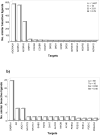Cross-pharmacology analysis of G protein-coupled receptors
- PMID: 21851335
- PMCID: PMC3717414
- DOI: 10.2174/156802611796391285
Cross-pharmacology analysis of G protein-coupled receptors
Abstract
The degree of applicability of chemogenomic approaches to protein families depends on the accuracy and completeness of pharmacological data and the corresponding level of pharmacological similarity observed among their protein members. The recent public domain availability of pharmacological data for thousands of small molecules on 204 G protein-coupled receptors (GPCRs) provides a firm basis for an in-depth cross-pharmacology analysis of this superfamily. The number of protein targets included in the cross-pharmacology profile of the different GPCRs changes significantly upon varying the ligand similarity and binding affinity criteria. However, with the exception of muscarinic receptors, aminergic GPCRs distinguish themselves from the rest of the members in the family by their remarkably high levels of pharmacological similarity among them. Clusters of non-GPCR targets related by cross-pharmacology with particular GPCRs are identified and the implications for unwanted side-effects, as well as for repurposing opportunities, discussed.
© 2011 Bentham Science Publishers
Figures




Similar articles
-
A structural chemogenomics analysis of aminergic GPCRs: lessons for histamine receptor ligand design.Br J Pharmacol. 2013 Sep;170(1):101-26. doi: 10.1111/bph.12248. Br J Pharmacol. 2013. PMID: 23713847 Free PMC article.
-
Chemogenomic approaches for the exploration of GPCR space.Curr Top Med Chem. 2011;11(15):1944-55. doi: 10.2174/156802611796391212. Curr Top Med Chem. 2011. PMID: 21470168 Review.
-
Thematic Analysis™: a chemogenomic approach to GPCR drug discovery.Curr Top Med Chem. 2011;11(15):1925-43. doi: 10.2174/156802611796391302. Curr Top Med Chem. 2011. PMID: 21470170 Review.
-
Orphan receptor ligand discovery by pickpocketing pharmacological neighbors.Nat Chem Biol. 2017 Feb;13(2):235-242. doi: 10.1038/nchembio.2266. Epub 2016 Dec 19. Nat Chem Biol. 2017. Retraction in: Nat Chem Biol. 2021 Apr;17(4):501. doi: 10.1038/s41589-021-00746-1. PMID: 27992882 Free PMC article. Retracted.
-
GLIDA: GPCR-ligand database for chemical genomic drug discovery.Nucleic Acids Res. 2006 Jan 1;34(Database issue):D673-7. doi: 10.1093/nar/gkj028. Nucleic Acids Res. 2006. PMID: 16381956 Free PMC article.
Cited by
-
A structural chemogenomics analysis of aminergic GPCRs: lessons for histamine receptor ligand design.Br J Pharmacol. 2013 Sep;170(1):101-26. doi: 10.1111/bph.12248. Br J Pharmacol. 2013. PMID: 23713847 Free PMC article.
-
A multi-label approach to target prediction taking ligand promiscuity into account.J Cheminform. 2015 May 30;7:24. doi: 10.1186/s13321-015-0071-9. eCollection 2015. J Cheminform. 2015. PMID: 26064191 Free PMC article.
-
CFam: a chemical families database based on iterative selection of functional seeds and seed-directed compound clustering.Nucleic Acids Res. 2015 Jan;43(Database issue):D558-65. doi: 10.1093/nar/gku1212. Epub 2014 Nov 20. Nucleic Acids Res. 2015. PMID: 25414339 Free PMC article.
-
Drug repurposing: far beyond new targets for old drugs.AAPS J. 2012 Dec;14(4):759-63. doi: 10.1208/s12248-012-9390-1. Epub 2012 Jul 24. AAPS J. 2012. PMID: 22826034 Free PMC article.
-
Enhanced Bystander BRET (ebBRET) Biosensors as Biophysical Tools to Map the Signaling Profile of Neuropsychiatric Drugs Targeting GPCRs.Methods Mol Biol. 2023;2687:15-30. doi: 10.1007/978-1-0716-3307-6_2. Methods Mol Biol. 2023. PMID: 37464159
References
-
- Kristiansen K. Molecular mechanisms of ligand binding, signaling, and regulation within the superfamily of G protein-coupled receptors: molecular modeling and mutagenesis approaches to receptor structure and function. Pharmacol Ther. 2004;103:21–80. - PubMed
-
- Jacoby E, Bouhelal R, Gerspaher M, Seuwen K. The 7TM G protein-coupled receptor target family. ChemMedChem. 2006;1:760–782. - PubMed
-
- Levoye A, Jockers R. Alternative drug discovery approaches for orphan GPCRs. Drug Discov Today. 2008;13:52–58. - PubMed
Publication types
MeSH terms
Substances
Grants and funding
LinkOut - more resources
Full Text Sources

